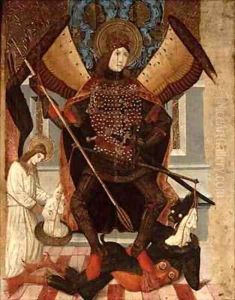Pedro Garcia de Benabarre Paintings
Pedro Garcia de Benabarre was a notable Spanish painter from the 15th century, active during the late Gothic period. His exact birth and death dates are not precisely known, but he is believed to have been born around 1445 and to have died around 1485. He is often associated with the town of Benabarre in the historic region of Ribagorza, now in the modern province of Huesca, Aragon, which is likely the origin of his surname.
Pedro Garcia de Benabarre is recognized for his work in religious panel painting, which was commonly commissioned by churches and religious institutions during that era. His style is characterized by the detailed representation of figures and a use of color that shows a transition from the medieval to the Renaissance styles, reflecting the changes in European art of the period. He was deeply influenced by Flemish painting, as were many of his contemporaries in Spain, due to the strong trade connections between the Kingdom of Aragon and the Duchy of Burgundy.
One of his most famous works is the altarpiece for the Chapel of the Holy Martyrs in the Cathedral of Roda de Isábena. This piece showcases his skill in composition and his ability to convey religious narratives with clarity and emotion. His work is also notable for the meticulous attention to clothing and textiles, which reflects the high value placed on detailed realism by the clients of the time.
Unfortunately, due to the limited documentation from the period, not much is known about his life, training, or the extent of his oeuvre. However, the surviving works attributed to him are considered important in the study of Aragonese painting of the 15th century. They are valuable for understanding the diffusion of artistic techniques across Europe during the late Middle Ages and the rise of Renaissance ideals.
Pedro Garcia de Benabarre's legacy is preserved in his contributions to Spanish Gothic art and the transition toward Renaissance aesthetics. His works can be found in various churches and museums, offering a window into the religious and cultural milieu of 15th century Spain. Despite the scarcity of biographical details, his art provides rich evidence of his skill and the artistic trends of his time.


